Contents
As an affiliate blogger trying to maintain engagement and drive conversions with your affiliate content, you may encounter challenges such as declining SEO rankings, decreased user engagement, and even lower conversion rates simply because your content has become outdated and you need a blog update.
In this situation, rather than panic, there are ideas you can implement to ensure your content regains its vitality and achieves those conversions you love to have.
This article provides 10 simple blog update ideas that can breathe new life into your affiliate content, keeping it fresh and appealing. These ideas will also help you optimize your content for better SEO, enhance user experience, and boost your affiliate marketing success.
10 Blog Update Ideas for Better Affiliate Content
There’s something to be said about keeping good content – just because it’s old doesn’t mean it’s bad. However, it is necessary to replace outdated information, so that your posts are reliable and optimized for gaining organic traffic.
This doesn’t mean rewriting every single post you’ve ever produced. Instead, it involves reviewing old posts to see what information still holds up and what is no longer relevant, optimizing for search engine optimization (SEO), and adding pertinent content.
With this in mind, here are 10 ways you can start updating the content on your blog.
1. Update Your Affiliate Links to Product Displays
Updating your affiliate links to product displays is a powerful strategy you can use to refresh your affiliate content.
Now, you might be wondering, what difference will this blog update make? Well, the answer is quite simple. Converting your plain affiliate links into an engaging product display makes your content more appealing to your readers.
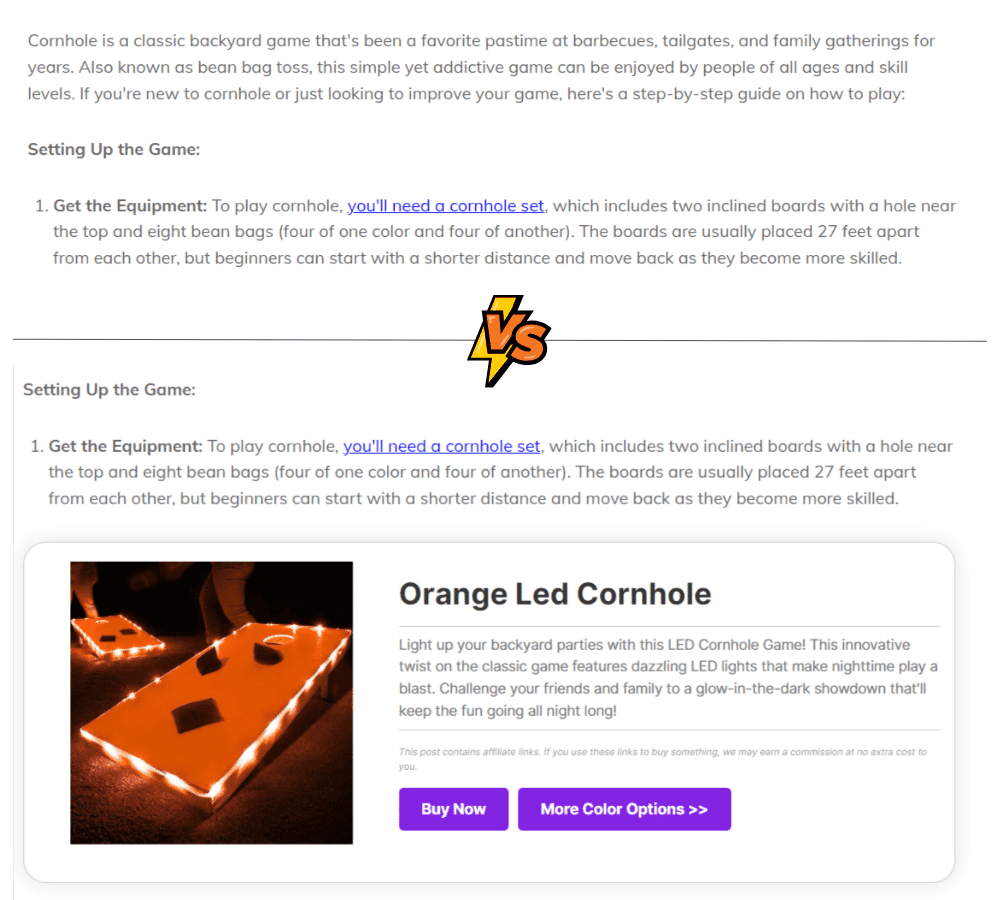
Ordinarily, most readers who encounter a blog with plain affiliate links will likely only stay on it for a short time, defeating the purpose of your content in the first place.
But with eye-catching product displays, your readers are more likely to stick around and explore what you have to offer. This leads to higher click-through rates and, ultimately, more affiliate earnings for you.
How do you create these captivating product displays for your blog? That’s where PrettyLinks comes in!
A cool feature of PrettyLinks Product Displays is the ability to add a review button. This takes readers to your detailed reviews and recommendations, without cramming everything into a small space.
You also get to flex your wits and customize your product display to match your style. Choose your display theme, product image, call to action, and even add a personalized badge to give it that special touch.
Using PrettyLinks to enhance your affiliate product display is the first step toward revitalizing your affiliate content.
2. Compile Similar Blog Content into Sellable eBooks
One of the perks of being a content creator is the endless potential for generating multiple income streams with your content.
Let’s say you run a health and wellness blog filled with posts on nutrition, fitness, and mental well-being. A blog update could be compiling those posts into a sellable eBook.
You can cover everything from diet plans to workout routines and more. This approach not only provides your readers with valuable resources but also generates extra income for you.
To make your eBook stand out, add some exclusive tips and strategically place your affiliate links where they fit. This adds value and makes your eBook more appealing.
Once your eBook is ready, you might wonder, how do you promote it and make sales from it? That’s where another very special PrettyLinks tool comes in handy!
PrettyPay™ offers a branded, one-click payment link that makes online selling incredibly simple. Using Stripe, it automatically sets up your sales pages and handles payment processing for you.
3. Keep Content Fresh for Higher Rankings
Readers crave new and up-to-date information. If your blog or website content feels outdated, they’ll quickly move on to find more current sources. Regular updates show your audience that you’re active and committed to providing them with the latest insights and trends.
Imagine you have a blog about technology. The tech world moves fast, and what was cutting-edge last year might be obsolete today. By regularly updating your posts, you ensure that your readers always get the most accurate and relevant information, keeping them coming back for more.
Fresh content also boosts your SEO. Search engines favor websites that consistently update their content, helping you rank higher and attract more organic traffic. Plus, it gives you an opportunity to revisit older posts and optimize them for new keywords, enhancing your site’s overall performance.
With PrettyLinks’ keyword replacement tool, updating your content with new products and key phrases becomes a breeze. This tool automatically monetizes your content by linking specified keywords to your affiliate links.
Imagine you’re doing a blog update on an old post with a new product. Instead of manually adding the affiliate link every time you mention the product, PrettyLinks does it for you.
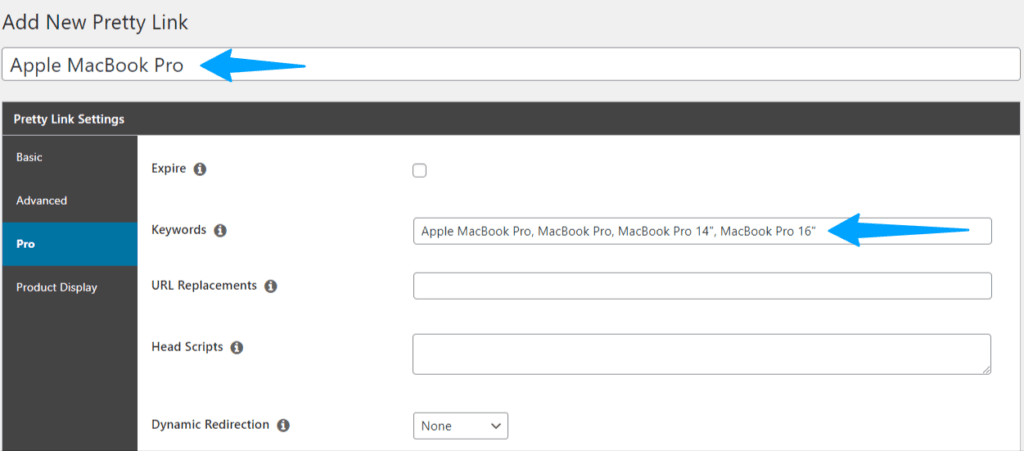
By keeping your content fresh and updated, you build trust with your audience, improve your SEO, and ultimately drive more traffic and engagement to your site. So, make it a habit to revisit your content regularly and keep it as dynamic as your niche.
4. Fix Broken Links for Completed Conversions
Broken links are a digital marketer’s nightmare. They can destroy your affiliate marketing efforts and damage your credibility.
Imagine your content convinces a reader to click on one of your affiliate links to learn more or make a purchase. Excited, they click the link, but instead of landing on the product page, they’re greeted by an “Error 404” or “Page Not Found” message.
Instantly, you’ve lost a potential customer, and they might not give you a second chance, opting instead for a competitor’s site.
Worse still, you could lose your affiliate status, as many affiliate programs have strict guidelines, one of which is having active and correct affiliate links at all times.
For these reasons, it only makes sense to ensure that your broken links are fixed through a regular blog update, and Link Health can help you do this.
Link Health by PrettyLinks scans your WordPress website in seconds and notifies you if a broken link is detected.
Link Health is easy to use once you have the PrettyLinks plugin tool. Click here to see the steps on how to activate Link Health on PrettyLinks.
Once activated, it will reduce your readers’ frustration, enhance their trust in your content, and ultimately boost your conversion rates by ensuring every click counts.
5. Optimize Images for Faster Loading Times
Images are a big part of your blog content, giving your readers a visual break and making your posts more engaging. But if your images aren’t optimized, they can do more harm than good by slowing down your site.
As part of a blog update, choosing the right format and dimensions for your images is essential. For example, use JPEG for photos, PNG for images with transparency, and SVG for logos and icons. This way, your images stay high-quality without being too large.
To help you with this, I highly recommend WP Smush. It is a widely used WordPress plugin that optimizes images by stripping hidden, bulky information from images and reducing their size without compromising quality.
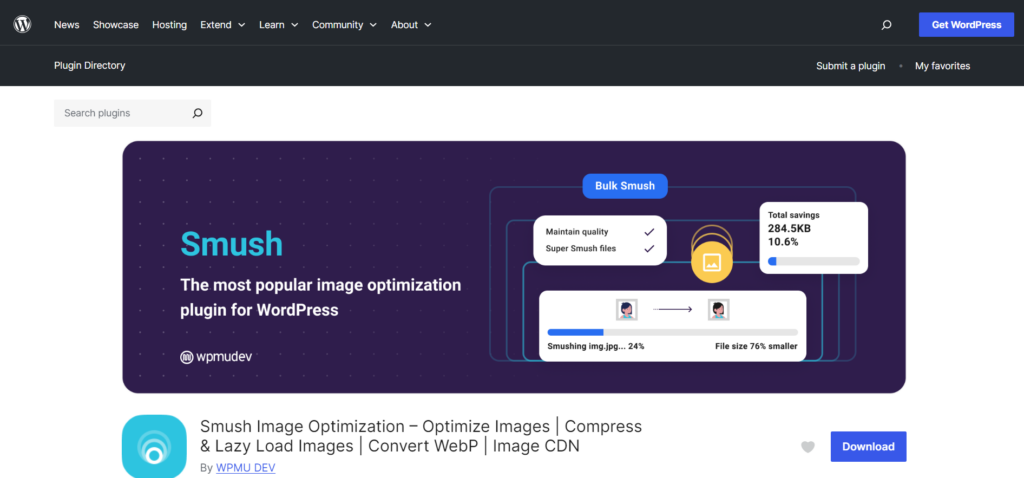
WP Smush also does lazy loading, meaning images only load when they come into the user’s view. This reduces the initial page load time and improves performance, especially on image-heavy pages.
By optimizing your images for faster loading times, you’ll make your site more user-friendly, boost your SEO, and increase the chances of conversions. This simple update not only freshens up your affiliate content but also makes your blog more efficient and enjoyable for your readers.
6. Rephrase Call-to-Action (CTA) Buttons
A blog update can be as simple as rephrasing your call-to-action (CTA) buttons to refresh your affiliate content. Effective CTAs use action-oriented language, are concise, create a sense of urgency, and personalize the message to address your readers’ needs.
When crafting CTAs, consider the reader’s position in your sales funnel:
- Awareness Stage: Attract and generate interest. Use CTAs like “Learn More” or “Discover Our Secrets.”
- Consideration Stage: Educate and build relationships. Try CTAs such as “Find Out How” or “See the Benefits.”
- Decision Stage: Convert prospects into customers. Use strong, direct CTAs like “Buy Now” or “Get Started Today.”
- Retention Stage: Retain customers and encourage repeat business. Opt for CTAs like “Continue Shopping” or “Subscribe to Our Newsletter”
- Advocacy Stage: Turn satisfied customers into brand advocates. Use CTAs such as “Share Your Story” or “Refer a Friend.”
For example, if your readers are in the awareness stage, focus on generating interest with CTAs like “Learn More” or “Discover Our Secrets.” On the other hand, if they’ve just read an insightful blog post and are ready to buy, a convincing “Buy Now” button is more appropriate.
By strategically placing and optimizing CTAs at each stage, you can enhance user engagement, improve conversion rates, and ultimately achieve your marketing goals.
More Tips for Rephrasing Your CTAs:
- Use Strong Action Words: Start with a verb that encourages action, like “Download,” “Start,” or “Join.”
- Create Urgency: Phrases like “Limited Time Offer” or “Only a Few Left” can prompt immediate action.
- Keep It Short: CTAs should be concise and to the point. Aim for 2-5 words.
- Personalize the Message: Tailor your CTAs to resonate with your audience’s needs and desires. For example, “Start Your Free Trial” feels more personal than “Sign Up.”
- Test Different Variations: A/B testing different CTAs can help you understand what resonates best with your audience and improves conversions.
By refining your CTAs, you ensure that each stage of your sales funnel is optimized to guide readers toward taking the desired action, ultimately boosting your affiliate marketing success.
7. Leverage Social Media Integration for Wider Reach
Integrating social media into your blog is a smart way to extend your reach, engage a broader audience, and enhance your affiliate marketing efforts. One of the best ways to leverage social media on your blog is to use social sharing buttons.
With PrettyLinks, you can easily add social sharing buttons anywhere on your posts and pages using the social buttons bar tool. This feature allows your readers to share your content on their preferred social media platforms, helping you reach new potential affiliate customers.
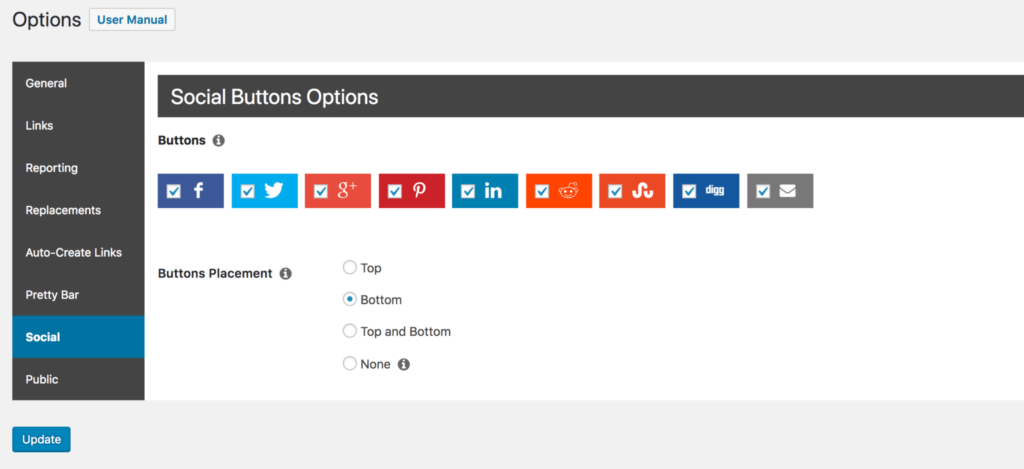
Click here to learn more about the social buttons bar and how to set it up on your blog.
Once added, your affiliate customers can use these buttons to share your content on whatever social media platform they prefer, generating new potential affiliate customers in return.
8. Build Reader Trust with User-Generated Content
Using user-generated content (UGC) in your blog is a powerful way to build a loyal community and enhance trust between you and your readers.
For example, if you’re promoting a product or service, highlight reviews and testimonials from customers who have successfully used them. Share their outcomes and personal stories to add authenticity to your recommendations.
Encourage your readers to share their experiences and provide reviews of the products or services you promote. Feature these user contributions prominently on your blog to show that real people are benefiting from your recommendations.
Another great strategy is to create a community forum on your blog where readers can ask questions, share experiences, and discuss topics related to your niche. You can then pick valuable contributions from this forum and highlight them in your main blog content. This not only provides fresh content but also makes your readers feel valued and heard.
Remember, you don’t need to implement every form of user-generated content available. Focus on what works best for your blog and the content you offer. By selectively using UGC, you can build a loyal and active readership that trusts and values your recommendations.
9. Implement a Content Audit to Optimize Performance
Conducting a content audit is essential as it helps to optimize content performance and improve overall content marketing efforts.
A content audit involves reviewing and analyzing all the content on your blog to determine what’s effective and what needs improvement. It helps you identify performance gaps, update outdated information, and fix SEO issues.
I highly recommend SEMrush to help you tackle all of this. It simplifies the process and gives you all the insights you need to optimize your blog.
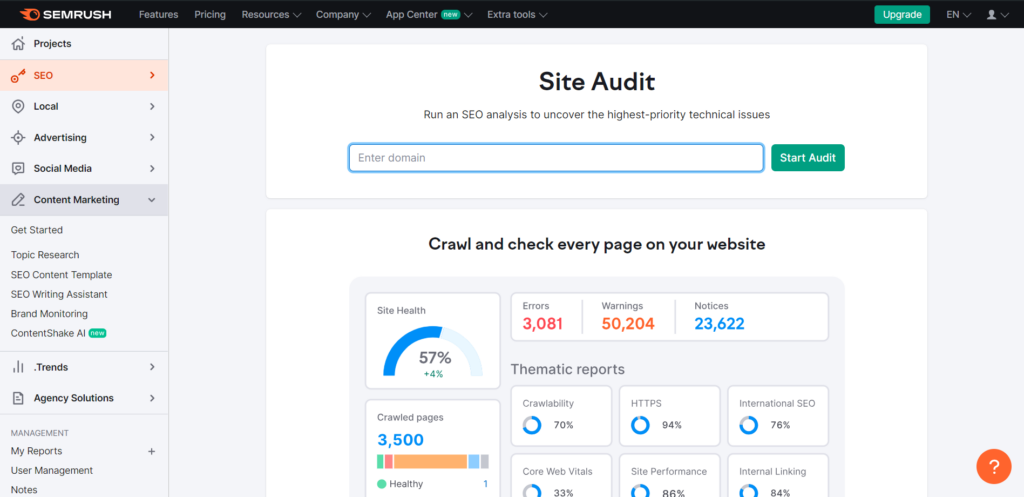
Here’s how SEMrush can help:
- Identify Content Gaps: Find out what topics you’re missing and where you can add new content.
- Set Clear Goals: Define what you want to achieve with your content, whether it’s more traffic, better engagement, or higher conversion rates.
- Assess Content Quality: Evaluate how good your content is and see where it can be improved.
- Review Metrics: Use SEMrush along with Google Analytics to check out important metrics like page views, bounce rates, and conversion rates for each post.
Doing a content audit can really refresh your affiliate content and boost your overall strategy. Here’s a simple way to get started:
- Gather Data: Collect data on all your blog posts, including traffic stats, engagement metrics, and SEO performance.
- Analyze Performance: See which content is doing well and which ones need some work.
- Update and Optimize: Refresh old info, improve SEO, and enhance the quality of your content.
- Focus on High-Performing Content: Use what you learn to focus on your best-performing posts and replicate their success.
- Optimize Underperforming Posts: Make necessary tweaks to boost the performance of content that’s not doing so well.
- Align Content with Goals: Ensure all your content fits your current goals and audience needs.
By doing a thorough content audit, you can boost your blog’s success, focus on what’s working best, and make sure all your content is aligned with your goals and what your audience wants. This leads to a better-performing blog and more effective affiliate marketing.
10. Implement Interactive Elements for Higher Engagement
Interactive elements can significantly boost reader engagement. They captivate your audience, encourage them to spend more time on your site, and increase the likelihood of conversions.
Depending on your content, consider incorporating elements like polls and surveys, infographics, quizzes and assessments, chatbots, and interactive videos.
- Polls and Surveys: Engage your readers by asking for their opinions. This can provide valuable feedback and make them feel involved.
- Infographics: Present complex information visually. Infographics are not only engaging but also easy to share, increasing your content’s reach.
- Quizzes and Assessments: Create fun and informative quizzes related to your niche. These can be highly engaging and shareable.
- Chatbots: Offer instant assistance and answers to your readers’ questions, improving their experience on your site.
- Interactive Videos: Use videos where readers can click on different parts to learn more or take specific actions.
When implementing these elements, ensure they are easy to use and enhance the user experience rather than distracting from your content. Here are a few tips:
- Keep it Simple: Make sure interactive elements are straightforward and intuitive.
- Enhance, Don’t Distract: These elements should complement your content, not overshadow it.
- Test Before Launching: Before making an interactive element permanent, test it to ensure it functions correctly and is optimized based on user feedback and engagement metrics.
Ultimately, your goal is to drive more affiliate conversions and improve reader engagement. Choose interactive elements that align with your content and audience needs, and monitor their performance to ensure they achieve their intended purposes.
By thoughtfully integrating interactive elements, you can make your blog more engaging, retain your audience’s attention, and increase your chances of converting readers into loyal customers.
Conclusion
Refreshing your affiliate content with these ten simple blog update ideas can significantly enhance your blog’s performance and profitability.
From updating affiliate links and compiling content into eBooks to conducting content audits and incorporating interactive elements, each strategy offers unique benefits that can drive more traffic, increase engagement, and boost conversions.
At first glance, a blog update incorporating these changes might seem arduous, but you need to tell yourself that the rewards are well worth it. You’ll build greater trust with your readers, keep them engaged longer, and ultimately drive higher conversions through your affiliate links.
Start today to implement these ideas, as they would keep your content fresh, engaging, and valuable to ensure your blog remains a trusted resource in your niche.
If you liked this article, be sure to follow us on Facebook, Twitter, Pinterest, and LinkedIn! And don’t forget to subscribe to our newsletter!









Leave a Reply